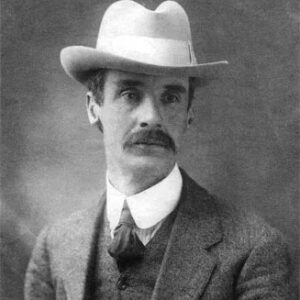Thomas Hayton Mawson, Lancastrian, workaholic and self-taught landscape architect, rose to the summit of his profession in a world where only trained architects dominated, due to their superior connections.
He established his fledgling design practice in Windermere in 1884 where his 2 brothers founded a nursery: amid the rapid building boom in holiday homes, they formed a reputation for lavish and elegant gardens in Arts & Crafts style – outdoor rooms for leisure and pleasure, adorned with a pergola, herbaceous border, rocky stream and pool and the all-important architectural layered terrace with a view.
Here he gained experience in carving his designs out of stone and slate hillsides, a skill which set him apart from his competitors such as Sir Edwin Lutyens. He often enlisted the help of James Pulham and his team, experts in building rock and water gardens, to his designs.
His early work included public parks (Coventry, Hanley, Burslem) but, to secure more commissions, Thomas published his methods in the book ‘The Art and Craft of Garden Making’, 1900; it was such a success that it was edited and re-printed in 5 editions, illustrated by architect colleagues Dan Gibson and Charles Mallows, and finally with photographs. His client list was stellar: a Maharaja, 2 princesses, members of the House of Lords, and increasingly, Edwardian industrialists such as Samuel Wareing, Gordon Sainsbury, Andrew Carnegie and, undoubtedly the most lucrative, Lord Leverhulme, with whom he made over 8 gardens and parks throughout a 20-year friendship. He conducted most of the initial surveys himself and oversaw the drawing of plans by a staff of 30; finally, he edited the planting plans himself because he considered this a most important part of a garden’s success. To monitor progress and check the way plants were becoming established, he returned several times to a site.
The family moved from Windermere to Hest Bank in 1911, chiefly to shorten the journey between the 2 offices in Lancaster and London. Thomas was invited to deliver lectures on landscape architecture to RIBA (Royal Institute of British Architects) and in cities abroad, in North America, Canada and Greece. His 3 sons joined the business, providing town planning schemes for some of these cities, schemes unfortunately rendered impossible by the outbreak of the First World War; his son James was killed in the battle of Ypres.
At the invitation of Lord Leverhulme, Thomas became involved in the new School of Civic Design, a course funded by his client at Liverpool University, where Thomas gave a fortnightly lecture on landscape design.
Later in life, Thomas was heaped with honours, among them were election to the Art Workers’ Guild; Fellow of the Linnaean Society; President of the Town Planning Institute; President of the Institute of Landscape Architecture. In his autobiography, The Life and Work of an English Landscape Architect, 1927, he wrote: ‘I think I have done a fair day’s work’.
His legacy is an harmonious style, which held its popularity until at least the 1970s; his emphasis on an architectural surround to the house, then loosening into a more naturalistic look further away is timeless, pleasing and adaptable to smaller gardens.
You can visit his parks in Lancashire –
- Barrow Park, Barrow-in-Furness Grade II
- Stanley Park, Blackpool Grade II*
- Falinge Park, Rochdale Grade II
- Haslam Park, Preston Grade II
- Lever Park, Horwich Grade II
- Rivington Terraced Gardens, Horwich Grade II
Or further afield:
- Fairhaven Lake, Lytham
- Hall I’th Wood, Bolton
- Higher Trapp Hotel, Simonstone
- Lord Street, Southport (partial)
